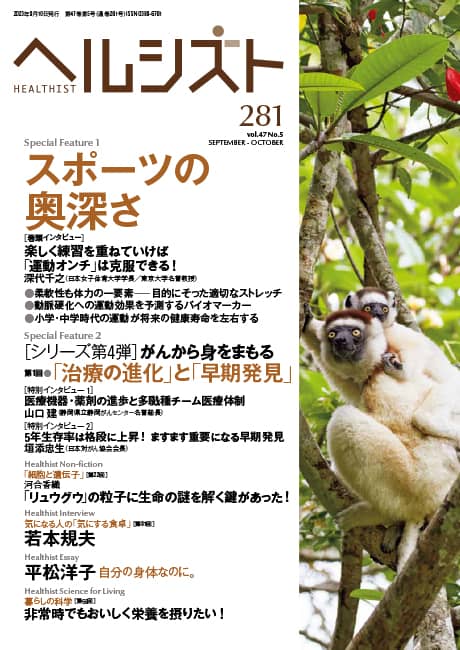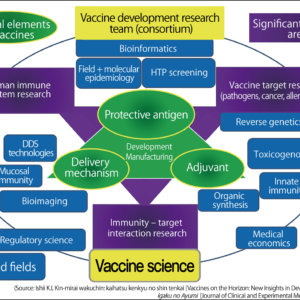It is generally thought that a supple body leads to better physical performance and prevention of injury, but the idea of “the more flexible, the better” does not always seem feasible. Being flexible means having a large joint range of motion, with muscles and tendons that can be stretched more easily. However, experts say that, given the nature of muscle tissue and the structural vulnerability of joints, having large flexibility is not necessarily a good thing. Nevertheless, flexibility is a component of physical fitness and efforts to increase it are required in any kind of exercise, therefore we need to carry out body conditioning exercises using stretches appropriate to our objectives.
Special Feature 1 – Sport’s Hidden Depths Flexibility is a component of physical fitness:
Stretch your body appropriately according to your objectives
composition by Yuko Watanabe
When I ask undergraduates at Waseda’s School of Sport Sciences what physical fitness is, most of them reply, “Staying power.” Another word for “staying power” is “stamina” (endurance), but this is only one of the components of physical fitness, as shown in Figure 1. Physical fitness is composed of a variety of elements, of which flexibility is one. In sport science, flexibility is defined as “the ability to engage in physical exercise smoothly and move the body within a wide joint range of motion.”
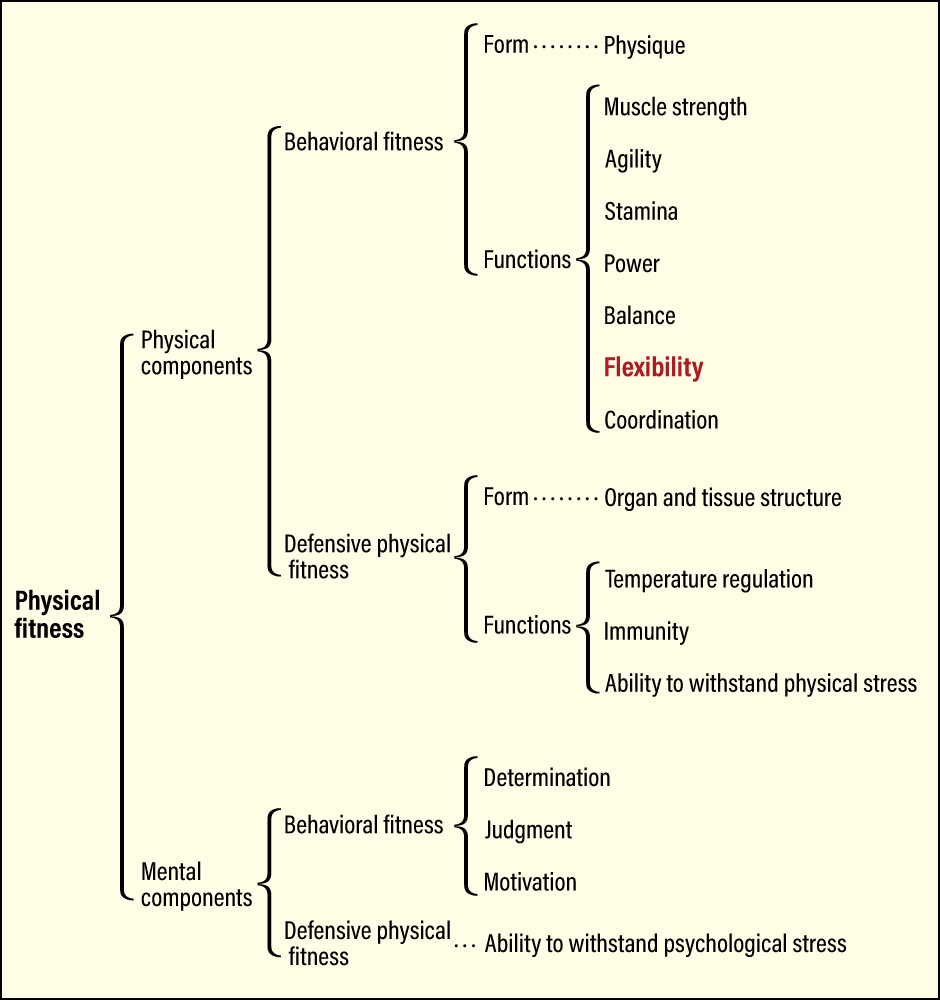 Source: Michio Ikai et al. ed., “Tairyoku to shintai tekisei” (Physical strength and fitness), Taiiku kagakujiten (Encyclopedia of Sport Science), Dai-Ichi Hoki Publishing, 1970.
Source: Michio Ikai et al. ed., “Tairyoku to shintai tekisei” (Physical strength and fitness), Taiiku kagakujiten (Encyclopedia of Sport Science), Dai-Ichi Hoki Publishing, 1970.
Figure 1. The components of physical strengthRegarding the concept of physical fitness, Professor Michio Ikai, an authority on exercise physiology, states, “Physical fitness consists of the body’s defensive ability to withstand stress and maintain life, and its ability to take action by performing work.”
Soft tissues have a bearing on joint mobility
The fact that flexibility is a component of physical strength appears to lead to the idea that the more flexible the body is, the better. In fact, the mindset that greater flexibility improves performance in sport and exercise, as well as helping to prevent injury has become prevalent.
The movements of our body are produced by the interaction of muscles, tendons, and joints. Most of the muscles used when we move our body are attached to bones, so they are also called skeletal muscles. Formed of muscle fibers which are soft at rest, they serve as an engine producing a great deal of power. Muscle fibers are connected to the tendinous tissue at both ends (the muscle-tendon junction), linking in series. Tendons mainly consist of bundles of collagen that appear wrinkled when viewed under a microscope. They act like a spring, stretched when force is applied and returning to their original length again when it is removed. The tendons and muscles in between cross joints, which link one bone to another. The joint also has ligaments around, which also have a spring-like property and have a bearing.
Just deviating a little from the subject of flexibility for a moment, let us look at the way in which muscles, tendons, and joints work, taking the example of a standing broad jump (also known as a standing long jump). When jumping forward from one the place to another, you can jump further if you crouch down before jumping (counter movement jump). Doing this exerts energy that taps into the elastic energy when your muscles, tendons, ligaments stretch, and then they shorten toward taking off. Along with energy from external forces, the force produced by our muscles (mechanical energy) is stored in our spring-like tendons as elastic energy, and, just like springs seek to return to their original form, this elastic energy is conveyed to our joints, causing our bones to move and enabling us to perform powerful, efficient movements. Running and jogging involve this kind of continuous series of interactions between muscles, tendons, and joints, while the use of elastic energy could be described as the fundamental mechanism of a variety of sports.
When you increase your running speed, the tensile force exerted on your Achilles tendons can reach 10 kN —— in other words, a massive 1 ton of force. This is the motive force for your Achilles tendon to stretch and store sizable elastic energy. At the same time, because it is such a huge force, it can lead to injuries such as ruptured tendons. Tendons are known to become tougher and more resilient with training, but it is vital to perform conditioning them in an appropriate way, so that they are neither too hard nor too soft.
- * kN : kilonewton. A unit describing the degree of force. 1 kN = approx. 100 kg.
Returning to the topic of flexibility, the determinants of flexibility include age, gender, and physique in terms of muscularity. Children are much more flexible than adults; toddlers in particular have very soft bodies, and their ability to adopt poses that adults cannot imitate is due more to their fragility than to the flexibility of their joints. At the other end of the time scale, we know that our flexibility declines with age, leading to the risk of falls. Moreover, women tend to be more flexible than men. This is because women have less muscle mass than men, which means that the joint mobility is larger as there is less tissue to stretch. Another reason that has been pointed out is that women’s tendons are softer and more compliant stretchier than men’s.
One of the studies conducted by our research team examines joint range of motion in the ankle, joint mobility, and muscle mass (calf muscle thickness) (Figure 2). We used two different instruments to take these measurements from 185 middle-aged and elderly subjects (116 women and 69 men) aged between 48 and 86 years old. The first was a myodynamometer fitted with a special motor, which we used to measure the rotation of the ankle up toward the shin (dorsiflexion). We then used ultrasonography to observe the calf muscle elongation. The other instrument was a special angle gauge, which we used to measure unaided voluntary dorsiflexion of the ankle. As a result, we found that joint range of motion and mobility are both dependent on muscle mass: range of motion is greater when there is less muscle mass (for the aforementioned reason), while mobility is greater when there is more muscle mass (because there is more strength to flex the joint). Particularly in the case of elderly people, it is necessary to maintain muscle mass in order to perform the activities of daily living, while maintaining joint range of motion through stretches and the like.
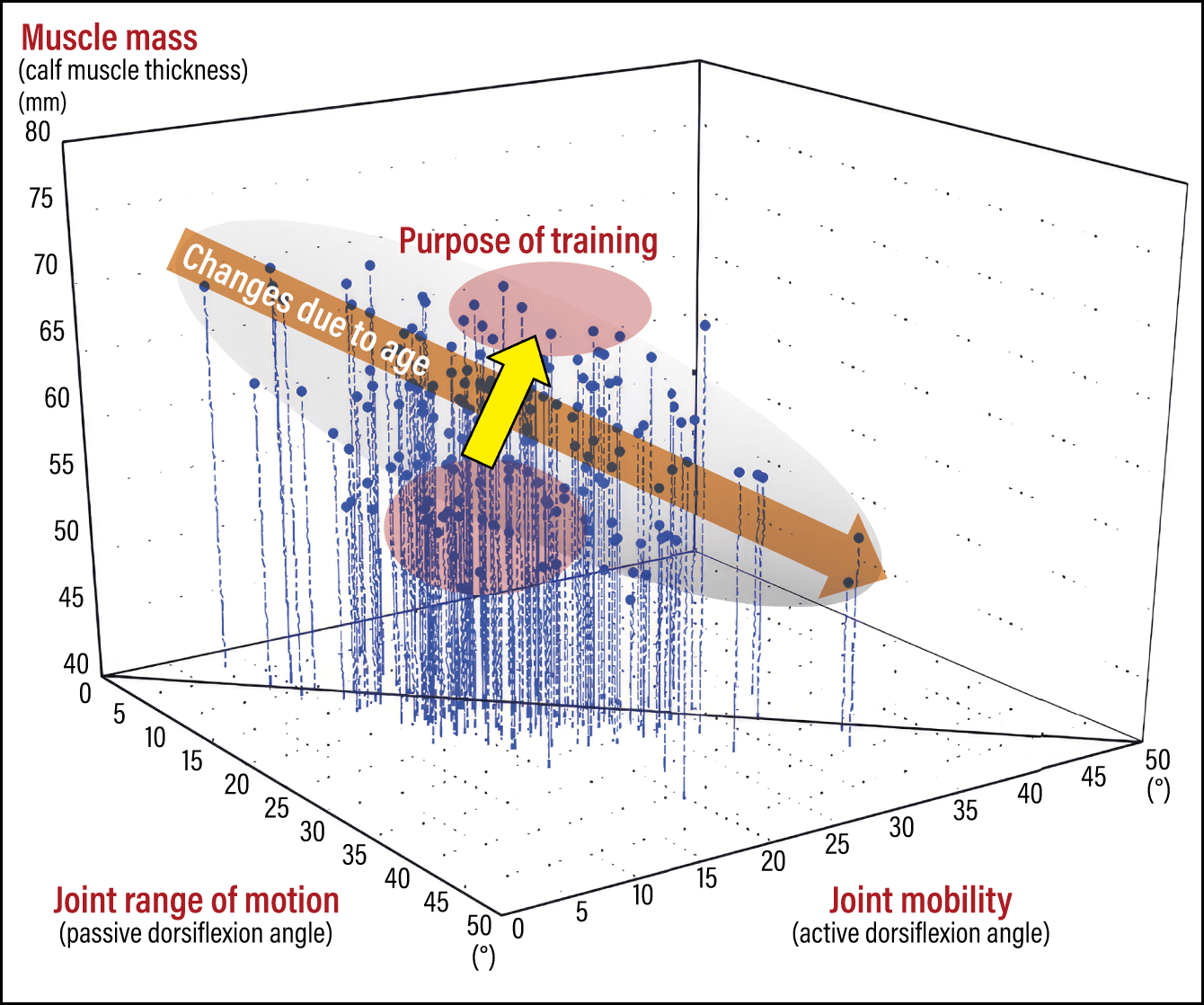 Yasuo Kawakami et al., The Japanese Journal of Physical Fitness and Sports Medicine, 2003.
Yasuo Kawakami et al., The Japanese Journal of Physical Fitness and Sports Medicine, 2003.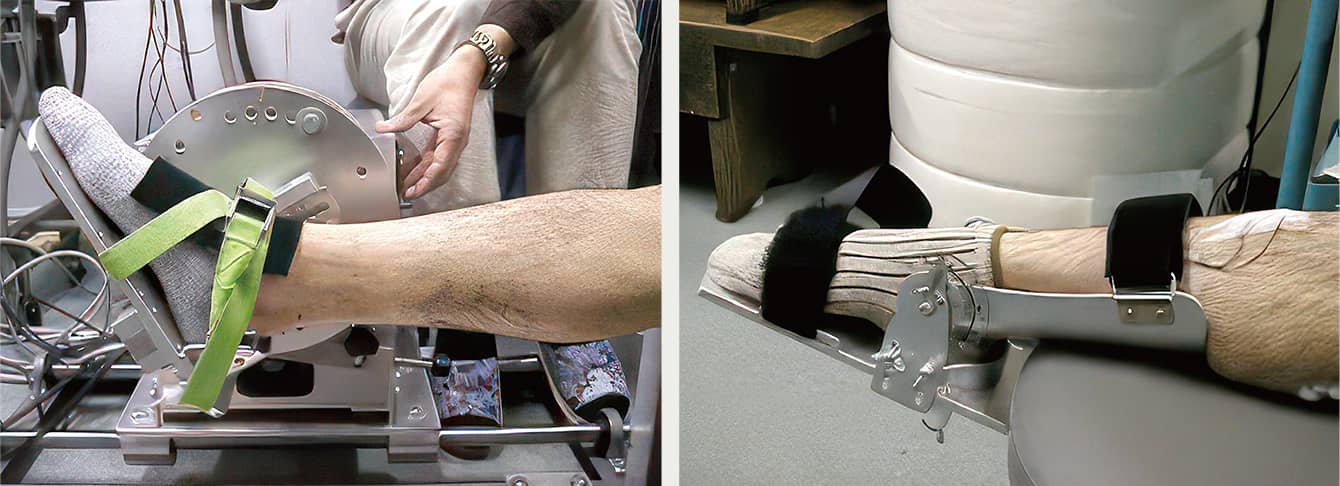
Figure 2. Passive and active components of flexibility related to muscle massA dorsiflexion stretch test. In the left photograph, an ultrasonic device has been fitted to measure calf muscle elongation, while a dynamometer fitted with a special motor measures joint range of motion. The right photograph shows the measurement of the subject’s unaided joint mobility with her/his own effort.
Movements beyond the range of motion lead to injury
I stated earlier that flexibility is a component of physical fitness. So, does that mean that infants and young children, with their flexible bodies, are fitter than adults? What I would like to consider here is the fact that the softness of muscles and tendons, along with the fragility of those tissues and joint structures, are also related to the determinants of flexibility. Accordingly, I do not think that having a large joint range of motion or easily stretched muscles and tendons is necessarily a good thing.
Ballerinas and other dancers achieve both muscle mass and a high level of flexibility through daily training, but everyone —— athlete or not —— can suffer injuries if their joints move beyond their personal range of motion. In this sense, having a body that is too flexible can increase the risk of injury. Numerous articles about flexibility have been published, both within Japan and overseas, but the debate around flexibility is complicated by the fact that, when looked at from the perspective of injury, one cannot state categorically that the more flexible a person is, the better. Our research team, too, is working on verification from multifaceted viewpoints, as we wish to scientifically prove the significance of flexibility.
Stretches believed to increase flexibility and prevent injury became popular in the U.S. between the 1960s and 1970s, and have now spread across the globe. In contrast to this reasonably substantial track record, the history of research into the scientific evidence behind these stretches is short, so various debates are still going on regarding their effects. Some research reports even state that stretching before exercise increases the injury rate.
To summarize findings to date, there are a number of different types of stretches and the majority view is that it is desirable to use the right type for the specific purpose.
This kind of stretch involves slowly and steadily stretching or flexing a joint without adding a rebound or momentum, until it is close to the joint range of motion, and then maintaining that position for anywhere up to 10seconds.
This kind of stretch involves adding a rhythmical rebound to stretch muscles and tendons. The momentum moves the joint just to the limit of its range of motion, so care must be taken when performing ballistic stretches.
This kind of stretch involves stretching muscles and tendons by using larger movements of the joints during continual movement of the body, such as while walking or jogging. The warm-up exercises performed by the Brazilian national soccer team that became famous worldwide during the World Cup are dynamic stretches of this kind. The anticipated effect of these stretches is to increase flexibility without reducing muscle strength.
For these reasons, rather than focusing solely on the kind of static stretching carried out during secondary school physical education classes, athletes today also warm up for their events with dynamic stretching, performing stretches that prioritize the advantages for joints, muscles and tendons by stretching muscle and tendon tissue to a reasonable extent, while increasing the range of motion.
Our research team examined the changes in ankle joint flexibility and in muscle and tendon extensibility after carrying out 10 dorsiflexion stretches of the ankle joint using a motor (Figure 3). From the results, we found that, when stretches are performed 10 times, the angle of ankle dorsiflexion increases with the number of times the stretch is performed. On the other hand, although muscle extensibility increases the first and second time, it plateaus thereafter. What is interesting is that, in the Achilles tendon, there was no change in the degree of elongation until the fifth time, but extensibility then gradually increased thereafter and was maintained in its heightened state during the last two times.
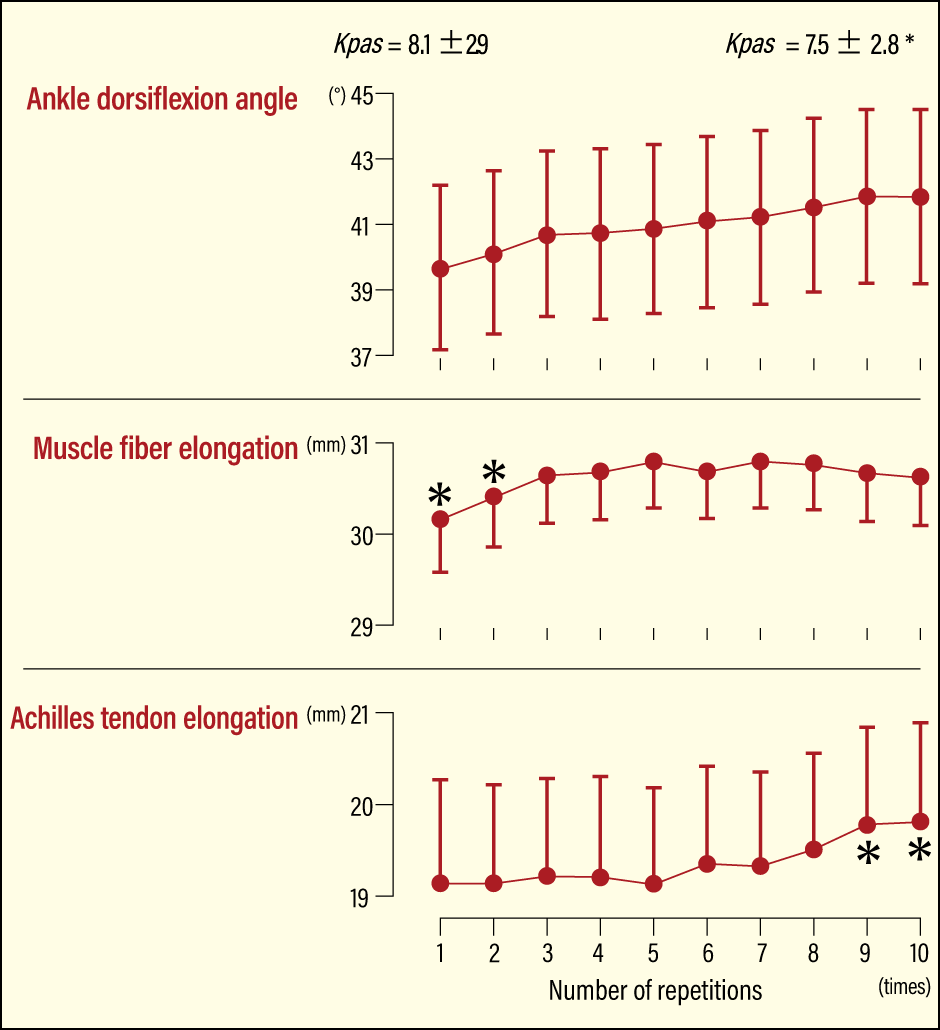 Yasuo Kawakami et al., 2001.
Yasuo Kawakami et al., 2001.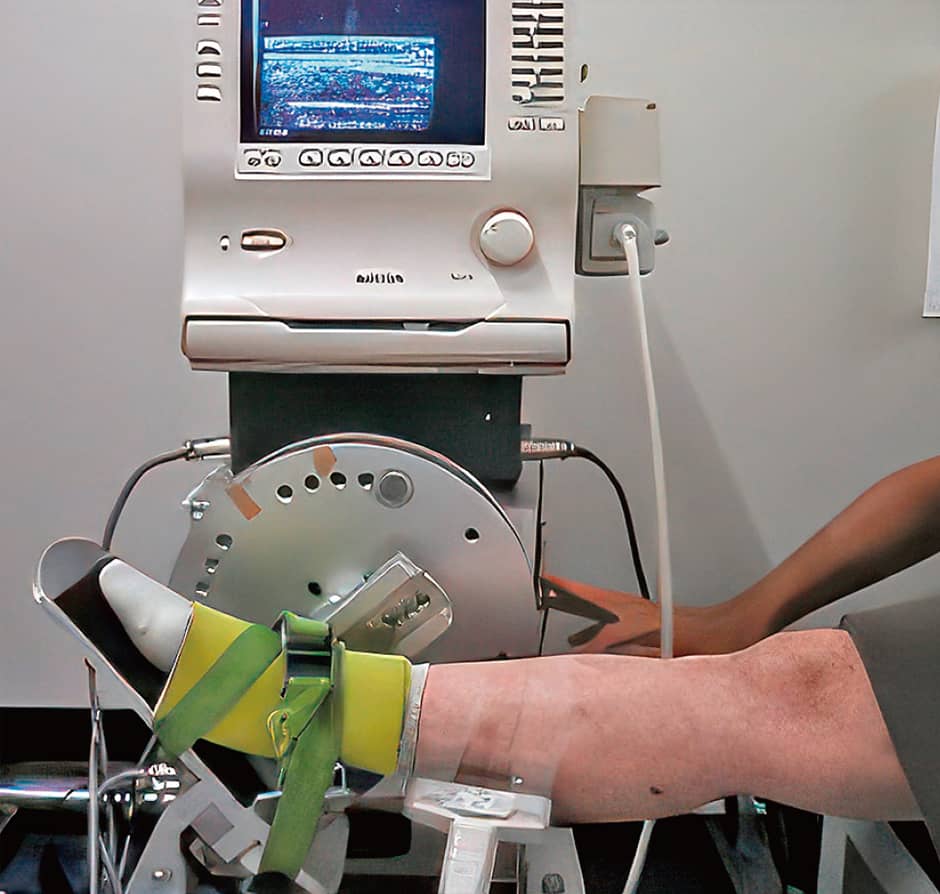
Figure 3. Increase in joint range of motion resulting from stretchingAnkle flexibility due to stretching was observed by means of three indicators: ankle dorsiflexion angle, muscle fiber elongation, and Achilles tendon elongation. In each case, the number of times the action had to be repeated for an effect to be observed differed, so it is desirable to consider the musculotendinous component in which you wish to achieve an effect before performing stretches.
Based on this, I recommend that —— whether you are an athlete or not —— you should not perform stretches in a desultory way, but rather should think about which aspects of the determinants of flexibility your stretches are stimulating and tailor the number and intensity of stretches accordingly. For example, if you wish to condition your Achilles tendon, stretching the calf only a few times is meaningless, and you should increase the number of repetitions. However, overdoing the musculotendinous tissues will reduce muscle strength. Reports from various studies have found that stretching before the main exercise causes a transient reduction in muscle strength. This would seem to suggest that both professional and recreational athletes should ensure appropriate stretching.
Flexible and powerful joint actions are vitally significant in healthy life
Opinions are polarized regarding the relationship between flexibility and stretching, but while static stretching does bring about a transient decline in muscle strength, practicing such stretches regularly would seem to be effective in the long run, as contraction and extension stimulate the muscles and tendons. In particular, studies have shown that, for elderly people, making stretching a regular part of their daily routine can act as a form of training to prevent a reduction in muscle mass. In the case of people whose muscle strength has declined so much that they are bedridden, having their carer stretch their major muscle groups would probably be effective.
When it comes to ankle, hip, and shoulder joints, which are the key to movement during both exercise and daily life, conditioning them is vital from the perspective of mobility. Ankles handle the movement involved in gaining purchase on the ground surface and then kicking off again to proceed forward, so a certain degree of mobility is required. In hip and shoulder joints, the rounded bone head fits neatly into a cavity called a fossa, resulting in joints with the ability to rotate very freely, and we use this feature of such joints in daily life and sport. However, this characteristic also means that damage to these two joints is common. To prevent joint range of motion from declining, it is important to perform stretches to move and condition them properly.
As part of a project for the Cabinet Office’s Cross-ministerial Strategic Innovation Promotion Program, in which our university was selected to participate, our research team conducted a detailed survey of 209 (106 men and 103 women) middle-aged and elderly people (between 40 and 81 years old). Walking speed is known to be closely related to life expectancy; through this study, we discovered that leg extension (kicking off with both legs in order to jump) power and muscle strength when bending and stretching the knee are related to walking speed and length of stride. This suggests that the muscles that move the hip and knee joints are crucial to improving walking function in middle-aged and elderly people. In addition, when we investigated the relationship between the time of day when people exercise and the degree of effect from the exercise, we found that, for elderly people, exercising in the morning is more effective than in the afternoon. Furthermore, it was also observed that walking ability in elderly people tended to decline in the space of three months if no stretches or other exercise were performed.
Based on the results of this three-year study, we developed SIPex , a program of exercises for middle-aged and healthy elderly people, which aims to increase muscle strength and the range of motion of the aforementioned three key joints, cultivate a sense of balance, and improve capabilities in regard to walking and other activities of daily life. SIPex consists of five movements: (1) trunk twist; (2) lunge (bending the hip and knee joints while standing with one foot forward and one back); (3) shoulder and hip rotation; (4) squat; and (5) tiptoe stand.
The important point about SIPex is that it does not require the use of special weights or other equipment and relies only on using one’s own weight as the load. This set of exercises takes just two minutes, so I hope you will incorporate it into your daily life to assist in maintaining a healthy body.







